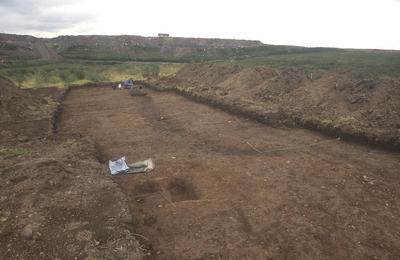
Excavations at Wester Balmuildy in 1997.
The site was discovered by studying aerial photographs. They revealed the existence of an enclosure covering 475 square metres, 200 metres south of Balmuildy's Roman Fort near the Summerston landfill. The excavations uncovered a bank and ditch which had probably surrounded a homestead. There may also have been a palisade (fence) on top of the bank. The ditch can be seen here as a dark band of soil curving along the side of the trench. In the foreground are two excavated features. These were filled with burnt material.
Archaeologists believe that the enclosure was deliberately dismantled and burnt. The remains of the turf bank were dumped in the ditch, levelling the site. A calibrated radiocarbon date with a 66 per cent certainty has been obtained from the site dating it to between 145-346 AD, with the most likely date in the middle of that range. This means that the enclosure existed just after the Antonine period of Roman occupation. Sites from this period are very rare in Scotland. Some neolithic (stone age) items were also found at the excavation.
Reference: 4889
Reproduced with the permission of the West of Scotland Archaeology Service
Keywords:
Antonine period, archaeology, Balmuildy Fort, banks, ditches, enclosures, excavations, homesteads, neolithic period, palisades, prehistory, radiocarbon dates, Romans, stone age
You have 0 images in your photo album.